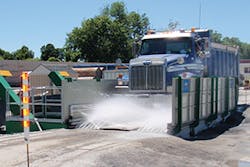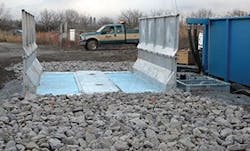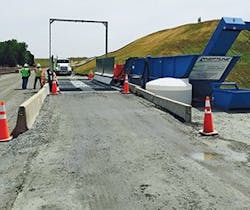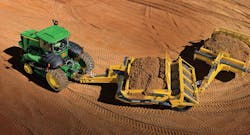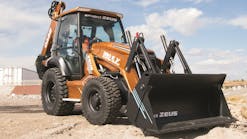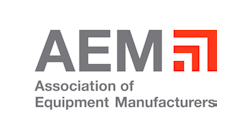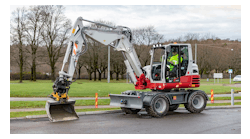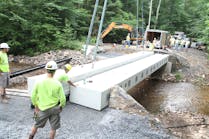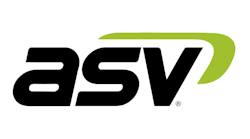Industry innovations often arise from the people whose everyday work poses a frustrating obstacle. “If we could only do…” or “If there was just a machine that did…think how much better our work product could be!”
Marshalling ideas plus experience and faced with the growing dilemma of keeping equipment clean, Garrett Excavating founded Neptune Wheel Wash Solutions in Hot Springs, AK. Tris Waystack, sales manager for Neptune, explains more.
“We are a family owned company with more than 65 years experience in the excavation industry. So, first and foremost we have extensive expertise with the grading, rock quarry, and mining business and it is this history that sets us apart from other wheel wash innovators,” he says. “We were our own first customer and learned first hand exactly what would be required of any wheel wash system. It had to be maintenance free, easy to operate, and designed to stand up to the heavy beating the systems take from the truckers.”
Waystack adds, “It was our own need for automated wheel washing that formed Neptune, and the real world experience with our own crews was the basis of how we developed our systems.”
He adds that while wheel washing is essential to keeping mud off the road, it’s pretty much a “forgotten piece of the overall equipment scheme in terms of having somebody who keeps an eye on operation and maintenance.”
“Most contractors use truck wheel washing, but our day-to-day experiences with trucks in our grading and mining operations was a critical piece; we knew what the pitfalls of the existing systems were and wanted to develop a better design, one that was as self-sufficient as possible. The system basically needs to run itself.”
Using an integrated PLC, “our Neptune Wheel Wash can run an auto-clean cycle in a fully automated mode. In other words, you don’t need a person to be present for its operation,” says Waystack.
Instead of a photoelectric eye that detects a truck and begins the system, Neptune uses an electromagnetic sensor, Waystack explains.
“The electric eye is a great idea but you have to keep it clean and someone always has to make sure it’s wiped off so it can detect a vehicle. What we have is a user-friendly metal sensor that never needs to be cleaned. When it detects ferrous metal, it begins its washing cycle.”
He describes the process of cleaning as taking about a minute to wash a typical dump truck.
“It takes about 11 feet to wash the full circumference of an 11R24 tire. Therefore our standard wash platforms for on-road trucks are 12 feet, 24 feet, and 33 feet. The truck progresses with the driver going about one to two miles per hour and the washing area includes all around the tire, the mudflaps and tire wells, the running boards, and it also cleans around brake calipers, and side nozzles get inside rims of the truck.”
The nozzles spray in high volume, with larger orifices, that Waystack says are “typically 5/16 of an inch wide in diameter. High volume and low pressure is the only safe way to clean underneath a vehicle. Most times the trucks being washed are not owned by the construction company so the owner does not want any liability issues.”
“Smaller diameter nozzles can get clogged with debris or sand but these are wide enough to avert that problem. Our system uses about 1,000–2,000 gallons of water in that 40-second wash with the thinking that rather than use a high pressure of water, we use a high volume. We also have a patented bladed platform, and this point loads the tires to really clean them, which is especially beneficial in areas with high clay soils that load up on treads.”
He says that this works by having the nozzles embedded in the platform, and they spray up from the bottom. Nozzles are also positioned from the side, so all areas of the undercarriage in and around each tire, including the rims, are washed off.
The platform actually flexes the tire tread, which Waystack says creates an air gap behind the soils, and “then this allows us to get the water behind the clay in that air gap and flush it out.”
“With the high volume of water, it really gets the tires clean. Then, the mud is moved by a scraper conveyer on the platform that pulls solids out and brings them up a 45-degree incline where it is dewatered and dropped into an optional sludge pit. The contractor can either use this sludge for fill or it can be appropriately disposed.”
The wash cycle water then returns to the containment tank for reuse which Waystack says can be from 3,500 to 20,000 gallons, “depending on the truck count on the respective job and soil type. Sandy soils need less water than heavy, dense clay soils.”
Operators have the choice of putting their steel containment tank underneath the platform, below ground, or on the side of the platform. While the Neptune system is designed to be free standing, and can be assembled in three to four days, Waystack adds, “If the job site is going to be for long-term, we pour concrete, which helps with the sub base stability and which also helps collect overspray to keep water from going onto the site.”
“Basically it is a closed loop recycling system that uses the same water over and over, and we do have a proprietary flocculant that is metered in as small doses that causes solids to coagulate and then drop out of the suspension. The water in the tank is then very clean for re-use, which is important because, for example, if you have eight trucks and they are running fill in and out all day long there might be as many as 80 trips a day. If they do a wash-out each time, the water needs to be clean to do that job.”
And for every hundred trucks “depending on the soiling,” Waystack says there can be 1 or 2 yards of soil that is captured from that wash water.
The Neptune system is available to contractors and owners through their national distributors as well as through their national rental fleet, Waystack says, “which serves customers in all 50 states and internationally as well.”
“When a customer contacts us, what we typically ask them for is truck count, soil type, and request they fill out a questionnaire that helps us match the right system to their needs. If we think it’s something more involved we’ll send a technician to the field to do a site visit and help them decide.”
Another feature of their customer service, he adds, is their factory supervision of startup and assembly, where a Neptune rep will oversee the system installation and train the site crew to its operations and working features.
“It can usually be assembled in under a day, but it may take up to three or four days, depending on how permanent the system is and whether we need to pour concrete as a base.”
Waystack says that the whole protocol for wheel washing is intended to keep mud off the road and keep vehicles clean to lower the risk of mud damaging mechanicals, but moreover, “it keeps local owners happy as well.”
“When residents see that there is mud everywhere and they are having to drive through it in their new car, they’re not too happy. Contractors have learned that clean sites make for both good stewardship of properties and good community relationships.”
Cattle Inspire Creative Thinking
What we may imagine as long-lost archived images really aren’t. Old memories and experiences can remarkably fall forward in our mental Rolodex and become just the right inspiration for a new idea when we are faced with a problem. This scenario is exactly what Jeff Lange, innovator and founder of Arizona-based JML Services LLC and Trackout Control Inc., recalls.
“In the ’90s I was employed at a large contractor company, but we were getting repeat violations for air quality due to the particulate matter going into the atmosphere from our removal of vegetation,” says Lange.
“In Arizona, it’s hot but also very dry, very low humidity, and the dust from a project being developed in the northern part of the state was getting the attention of authorities.”
After several citations (each one of increasing amount), management told Lange, who at the time was in charge of risk and safety, “to do something, I don’t care what it is, just figure it out.”
It was then that Lange remembered his early years in the Three Corners area of Iowa on the Mississippi River when the light bulb of invention was ignited.
“In Clinton, Iowa, where I grew up, it’s pretty flat, and there is a huge farming effort of livestock, particularly cattle. And I remembered those cattle guards we were driving over at regular intervals—they about shook the teeth out of your head,” he recalls.
Lange explains that farmers and ranchers install these large metal frames having rows of tubular steel set at interval spacings on every farm property. The cattle guard units are placed grade level at road entrances or at vehicle access entrances to fenced pastures that then allow equipment access.
“These devices are designed so that vehicles can drive over them but cattle cannot cross them as their hooves slip, and they instinctively know they will be injured,” explains Lange.
“So, working on that premise, I thought about modifying that design—vehicles like work trucks could cross them and safely shake off the dirt, rocks, and debris, but one that cars could pass over as well. The trick was making it so that it would accommodate a low-to-the-ground sports car like a Miata but also a dump truck and do the same job on both without injury to the chassis or undercarriage of either,” says Lange.
After several incarnations in design and building, he says he came up with a model that had the right dimensions. “I took it to the local County to show them since it was the county air compliance officers who had made visits to our site and issued the citations.”
“Those guys were pretty impressed and as I was still with the contracting company who was all in favor of me developing this product, I realized I had a patentable invention,” he adds.
In the face of working his “day job” and also his “side job” acting as an independent expert witness in risk management and safety operations, Lange was overwhelmed with juggling too many balls in the air. After receiving good news from the US Patent Office, Lange decided to retire from the construction business and focus on developing his invention.
“I filed and received four patents, including a methodology for ‘rumble grates’ and now it’s a registered product. My Rumble Grates are all manufactured here in the US with people I hand-picked to weld and fabricate these out of A35 steel. Then they are undercoated and rust-proofed, then final paint coated. Each one is stamped with serial numbers and the four patent numbers to protect my rights.”
The Rumble Grates can carry 115,000 pounds of rubber vehicle Lange says, explaining that, “These need to be stout because construction sites might have cranes and loaders crossing the grates so they have to hold up for heavy equipment, not just the trucks.”
Explaining that the product is low tech “but so incredibly effective,” Lange says he got a bonus testimonial in product endorsement from the California county of San Joaquin.
“This was a lucky break and I took a bunch of my equipment, plus others who were trying to imitate my product, out to California. The County tested all of them and they were very pleased, saying that Rumble Grates removed 85% of dirt and debris on a vehicle.”
He adds that vehicles simply drive over these and the special configuration of his steel design literally shakes off the dirt and soils “that in most situations, are the bane of construction sites that track dirt onto the road and risk getting a violation.”
“When you get the dirt off and it falls below the surface into the pit below, you are removing the element of bringing dust into the air and also dirt on the roadway.”
One of Lange’s patents was unique in the very sense that it was granted at all.
“Getting a patent for methodology is very difficult and almost never happens. My legal support staff was very skeptical; however, through a sequence of events that eventually brought senior Patent Office officials into the process, I did receive it. This methodology patent pairs the unique design and construction with the process—that is to say, the methodology of its use—in driving over it.”
Another benefit beyond the Rumble Grates effectively removing debris is their portability.
“You can just pick these up with loading equipment and move them to your new site or somewhere else on your existing area without much effort and they can go to work in a new location. But make no mistake, these are heavy duty, and each section is a robust unit of 2000 pounds of steel to do the job. Once these are set down on your space they are not going to move until you move them.”
He says that the Rumble Grate unit comes in 10-foot-wide and 8-foot-long sections.
“So you can put them both side-by-side to make them wider for larger vehicles and add length to them to gain more tire rotations. I determined that 24 linear feet, which would be three units, is the ideal length to remove 80–90% of the truck debris.”
While the original Rumble Grates worked perfectly on a job site, Lange says he later invented a different model called the Grizzly Rumble Grates.
“In home construction, these big home builders, the ones doing those multi-million dollar homes, wanted something wider, so I made these at 20 feet wide to span gatepost to gatepost at their sites. The Grizzly Grates are less aggressive than the originals so while contractor vehicles will still be cleaned on exiting during new home site building, the current residents’ high-end vehicles can go through them without anxiety their cars will be harmed,” says Lange.
Another modification Lange says works is to have contractors scoop out 13 inches of soil and put the grates in the low spot, fill it up with water that is kept contained by a geotextile, for example. The Rumble Grates would then be submerged in this water and would be the first pass for a semi with mud, he says.
Then “the next pass would be to drive over a span of gravel, and then last, you would drive over a set of above ground Rumble Grates. You can achieve a great cleaning process with this three-step pass and it’s low tech, using no electricity, requires no personnel or attendant, and still does a great job. Contractors love this versatility and adaptability of the product to whatever unique situation they have.”
Lange describes how it works to get results. “When you drive over it, square tube and flat steel bars change elevations and cause the ‘bumpety bump’ you feel as you drive over. It is this bumping action that so effectively knocks dirt and debris off tires. But it’s getting these dimensions and spacings just right that is the ‘secret ingredient’ that makes this work—you can’t just drive over a series of platform rails and hope for the best. It really is ingenious in its design that not only removes dirt and rocks from hauling vehicles, yet has no effect on a high-priced sports car as well.”
After selling these nationwide since 2003, Lange says he’s never had a claim on their performance, construction failing, or any other reason.
“I’ve sold these everywhere—West to East Coast in the US and also Hawaii and the Virgin Islands. Now, landfills are starting to use them and put them on retaining walls as the structure to support them, so they are being realized as a tool for multiple purposes to achieve cleaner air, and a cleaner environment all around. It’s a low investment that quickly pays for itself in eliminating violations and fines.”
Selling Solutions Over Products
Describing the attributes of MobyDick Wheelwash, sales director Mike Whitney emphasizes, “The number one attribute is our company itself. We’re a world leader in wheel and undercarriage washing and the MobyDick brand in the market is synonymous with quality service.”
Concurring with that assessment, North American sales director, Bob Lodi adds that the wheel wash process, which began in Europe, specifically Switzerland, embodies what that country is known for.
“Everyone has an image of picturesque Switzerland—cleanliness, pristine beauty as the benchmark standard. So it’s not surprising that the concept of cleaning construction equipment to maintain the environment and an iconic image began in the shadow of that Alpine region.”
Whitney says that Swiss innovator Edwin Frutiger founded the eponymous company in 1957 manufacturing construction equipment and began its wheel washing branch in 1985. This division was then introduced to the US in 2002. In 2014, the MobyDick dust suppression system was launched and its next generation, MobyDick ONE was introduced to the US in 2017.
Whitney adds that “there is a lot more to this than just spraying water on an undercarriage; a great deal of engineering goes into these systems. When the concept of wheel washing took off, largely due to regulatory pressure in dust control and stormwater regulations, many companies entered the market. However, performance was often lacking and contractors were less than thrilled with the outcome of their investments.”
But, he says, once MobyDick became known for its performance, Frutiger soon became a market leader and now “we’re right up there as a known quality and product brand like Kleenex and Xerox.”
“We have a lot of studies we’ve done by partnering with universities who had monitored the flow of water, the effectiveness of heavy debris removal, the angle of nozzles. Nobody can beat us in the effort of bringing the water to the recycling tank and how that wastewater is treated.”
But the company mission is not just to wash a truck, but to address a problem. Whitney says, “When they call us, they are tracking out mud and material and we have to first find out what they want to accomplish, what level of cleanliness is required for each respective situation. Then this drives the type and level of system they benefit most from.
“We have to look at their facilities and do more than just sell an apparatus that sprays water.”
Lodi adds, “Wheel washing, since it originated in 1985, is now the accepted norm—from quarries and mines to housing projects. We don’t have to explain what wheel wash is, but rather ask, ‘What is the problem you are facing?’ They may need a portable system or one that is more permanent. Giving them alternative solutions to quantify the level of performance needed and then through our field services accommodate those needs with assembly and layout.”
He offers a scenario of question and answers that can occur between customers and MobyDick.
“First we listen to their situation, which might typically be ‘I own many trucks, I’m driving through mud, now they’re out on the streets and public highways and I’m getting complaints.’ So then we ask them, how many trucks? And that helps us calculate the water and recycling. Then we look at the cohesiveness of the material and number of gallons in a recycling pit that would adequately process and return the water to optically clear condition back to the platform. Drivers don’t ever see brown water.
“Next, we ask how much space they have, is there a lot of land? Is it a confined space? From that, we configure the recycling pit, its size and location, and then figure out how much power is needed to run that. Customers may be working on a budget or they may want some additional features we offer. We present all the options and then let them decide,” explains Lodi.
He says that since its inception in 1985, the company has gained the practical experience and aggregate information over time of what works and what doesn’t. Now they’ve come up with a formula that examines soil removal and rate of absorption out of the water based on the type of soil in each respective customer situation.
“From our process we can determine the rate of high-volume water use, using low pressure in the cleaning process. This is based on a scale of 1–10, light versus aggressive graining, times the number of trucks per hour. Once we have a figure, we can calculate the volume of water needing to be recycled and capturing the most amount of solids.”
Whitney adds that this proprietary formulation and analysis is “what separates the milk from the cream, if you will, from designing through the manufacturing process to the delivery and the follow-up relationship built between ourselves and our customers.”
In 2016 their latest system the MobyDick ONE was introduced in Munich and brought to the US in March 2017.
“Now we can accommodate not just rubber-tired vehicles but any track-type vehicles. The angle profile of the nozzles creates a system that will wash tracks and tires. These are 16- to 18-degree spray angles and you get the water on the tire as it is coming in and then chasing it as it is going out. At a higher angle, once you get beyond five or six inches, water begins to atomize and loses its pressure. Our goal is to have nozzles at just a specific angle such that they impact the tire with the spray and three or four inches high maximizes the kinetic energy delivered by the water for optimum cleaning,” explains Whitney.
The nozzles, he says, are smaller with less overall size, and the nozzle plates are interchangeable to take different size nozzles making it “a very flexible system. It can all be adjusted, and this is one of our patented components.”
Then the water is collected in a 40,000-gallon recycling tank which is under the wash platform but designed so the water flows to the center of the platform and is then directed to the tank.
“Inside the recycling tanks, the bulk of the dirt is pumped into a chamber which can go to a landfill or used for cover or repurposed for aggregate. You don’t want a lot of complications in this system and our design is the lowest type of maintenance,” affirms Whitney.
“We’re finding the low volume water technology works great. Truck fleet owners are looking to minimize their downtime contending with material build up on their vehicles, which creates heat on tires and brake systems and ultimately more problems,” explains Lodi.
And the pumps at the heart of the system moving all the water are also made by Frutiger. Lodi says these pumps are designed “knowing we are going to be using them in nasty, recycled water, made especially to meet the test of the on-off cycle, which is a primary cause of pump wear. There could be 300 washes a day, with 30–60 second on-off uses so they need to hold up. Most see a life of five to seven years under these rigorous conditions, but they can easily be re-built and return to service. However, I might add that one of my first pumps I sold back in 2003 is still going strong. So, it all depends on the individual circumstances.”
Lodi concludes, “As we see more regulation and enforcement on fugitive dust and stormwater requirements, our products will be there to meet these requirements, reducing road hazards and improving fleet owner efficiency.”